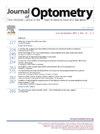A virtual approach: Systematic review and meta-analysis of virtual reality-based therapies for convergence insufficiency
IF 1.8
Q2 OPHTHALMOLOGY
引用次数: 0
Abstract
Convergence insufficiency (CI) is a common binocular vision disorder that significantly impacts visual comfort and quality of life. It has been hypothesized that CI therapy can also be provided effectively with Virtual reality (VR). Recently, a few studies were conducted on virtual reality-based CI therapy. However, to the best of the authors' knowledge, no systematic review and meta-analysis has been performed on the effectiveness of VR-based CI therapy. Therefore, this study aims to fill this critical gap and investigate the effectiveness of VR-based CI therapy. Consequently, it may be helpful to the clinicians, patients, and researchers to choose therapy, and develop future research studies. A systematic search was conducted on Google scholar, Scopus, PubMed and Science Direct until October 1, 2024. A total of 649 studies were screened, of which 3 studies were eligible to be included. We evaluated the quality and risk of bias for the included studies. Using the random-effects model, we found an overall mean difference of 3.38 (95% CI: 1.61, 5.16) before and after VR-based therapy. I² was 54.82% in our study, which indicates moderate heterogeneity. Then, we performed a Q test and found Q (df = 2) = 4.3593 and p-value = 0.1131, which indicates that albeit some heterogeneity observed in our analysis, it was not statistically significant. We also performed Leave-One-Out sensitivity analysis, which indicates that the overall findings of our analysis were relatively stable and not excessively dependent on any single selected study. No significant evidence of publication bias was found by using a funnel plot, Begg's test (Kendall's Tau = 1, p-value = 0.33), and Egger's test (intercept = 2.45, p-value = 0.40). Although we found VR based CI therapy has a positive effect, small sample size and variability in study methodologies make the current evidence insufficient to draw definitive conclusions regarding its effectiveness. Further studies are required to have more robust and reliable data.
虚拟方法:基于虚拟现实治疗收敛不足的系统回顾和荟萃分析
会聚不全(CI)是一种常见的双目视觉障碍,严重影响视觉舒适和生活质量。假设CI治疗也可以通过虚拟现实(VR)有效地提供。最近,有一些基于虚拟现实的CI治疗的研究。然而,据作者所知,尚未对基于vr的CI治疗的有效性进行系统评价和荟萃分析。因此,本研究旨在填补这一关键空白,并研究基于vr的CI治疗的有效性。因此,它可能有助于临床医生、患者和研究人员选择治疗方法,并开展未来的研究。系统检索谷歌scholar、Scopus、PubMed、Science Direct,检索截止至2024年10月1日。共筛选649项研究,其中3项研究符合纳入条件。我们对纳入研究的质量和偏倚风险进行了评估。使用随机效应模型,我们发现基于vr的治疗前后的总体平均差异为3.38 (95% CI: 1.61, 5.16)。在我们的研究中,I²为54.82%,异质性中等。然后,我们进行Q检验,发现Q (df = 2) = 4.3593, p值= 0.1131,这表明我们的分析中虽然观察到一些异质性,但不具有统计学意义。我们还进行了Leave-One-Out敏感性分析,这表明我们分析的总体结果相对稳定,不过度依赖于任何单一选择的研究。采用漏斗图、Begg检验(Kendall's Tau = 1, p值= 0.33)和Egger检验(截距= 2.45,p值= 0.40)均未发现显著的发表偏倚证据。虽然我们发现基于VR的CI治疗具有积极的效果,但样本量小,研究方法的可变性使得目前的证据不足以得出关于其有效性的明确结论。需要进一步的研究来获得更有力和可靠的数据。
本文章由计算机程序翻译,如有差异,请以英文原文为准。
求助全文
约1分钟内获得全文
求助全文

 求助内容:
求助内容: 应助结果提醒方式:
应助结果提醒方式:


